There’s always a feeling that you’re doing it wrong, that it could be better somehow. If you rush the process, you may well come to regret it later. The small problems you think you can live with only become more obvious over time, and bother you more.
No, I’m not talking about looking for a romantic partner. I’m talking about something much more important: picking up stitches for buttonbands, edgings, and modular designs like log cabin knitting and entrelac.
Even the terminology is difficult: we tend to use “pick up” and “pick up and knit” interchangeably, even though they’re not really the same thing.
Pick Up, No Knit
When we say to “just” pick up stitches, we mean to feed the tip of the needle through the edge of the fabric, putting loops from the fabric on the needle.
There’s no yarn used for this. Pick up one strand (or leg) of the stitch at the edge. (It’s practically impossible to pick up both legs of each stitch.)
When you’ve got stitches on the needle, you could then join yarn and work across them, but you don’t have to. This technique is used in situations where you need loops but no yarn attached: to set up for a three-needle bind off or a Kitchener stitch seam, for example.
Pick Up and Knit
When we say to pick up and knit, we mean to use yarn to “knit up” stitches along the edge. You are to grab the stitch (or some other loop) at the edge of the work with the working needle, wrap the working yarn around it, and pull the yarn through, completing it like a normal stitch.
(You can also pick up and purl: poke the tip of the needle through the edge from back to front, then wrap the yarn and complete the stitch as for a purl.)
This requires yarn, of course. It might already be attached to your work—as in picking up stitches along the edge of a sock heel flap. But if you need to join yarn, here’s my trick:
For the first stitch, leaving yourself a decent tail—3 or 4 inches/8-10 cm—just wrap the unattached yarn around the tip of the right-hand needle, and pull that through to create the first stitch.
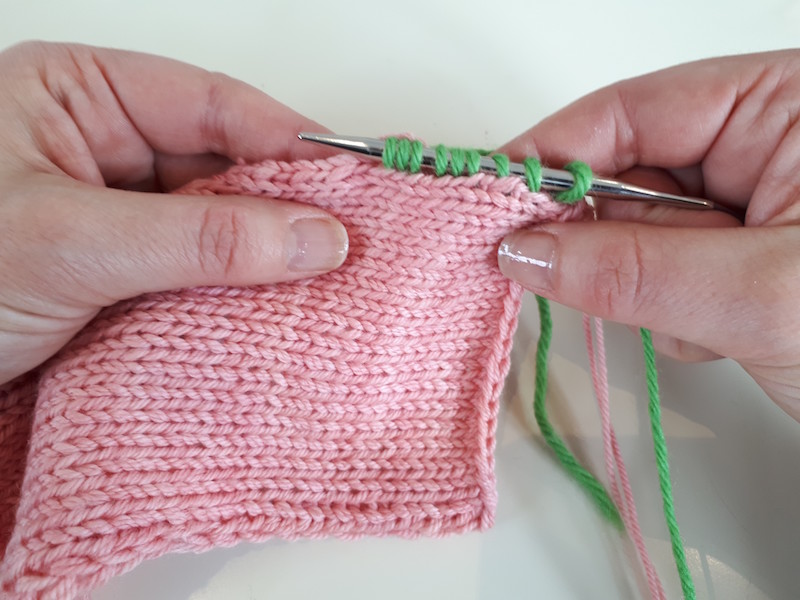
Then, when picking up and knitting the second stitch, wrap both ends of the yarn around the needle.
For the third stitch, drop the tail end, and continue with only the working yarn. This anchors the new yarn, in a tidy and low-profile way.
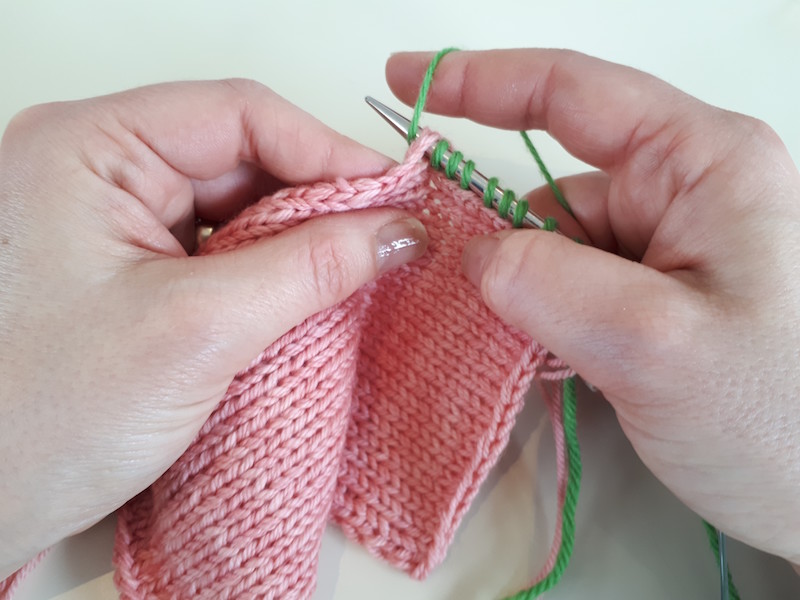
(You’ll notice a theme here: tidy.)
Work both strands of the doubled-yarn stitch together, when you come back to it.
When doing a pick up and knit, I strongly recommend that you pick up the full stitch, both strands of the edge stitch as you work across. It makes for a much tidier join.
Picking up only one strand or side of the edge stitch makes for a sloppier edge.
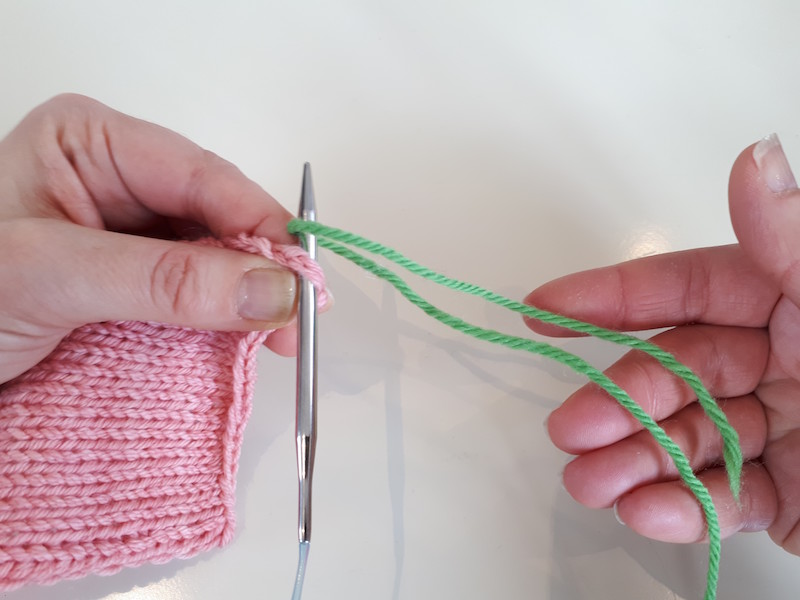
Interchangeability
At a basic level, these two techniques result in the same thing: new stitches on the needle. If, after picking up (but not knitting) all the way along the edge, you join the yarn and work across the stitches, you end up in the same basic place: new stitches where there weren’t any before. The difference between the two executions is in the edge. If you do the pick-them-all-up-first-and-then-work-across-them method, you’re putting all the stitches/loops of the edge under stress at the same time, requiring them all to stretch to accommodate the needle. If you work the pick-up-one-then-knit-it-before-picking-up-the-next version, then the stress on the edge is reduced—the stitches/loops are only needing to accommodate the yarn. The other difference is where you can put the needle—as noted above, it’s harder to grab both legs of the edge stitch/loop with the first method.
Although the imprecision of the language is a challenge, if you see an instruction to either “pick up” or “pick up and knit” without further comment or detail, you can generally assume you should work a pick up and knit.
The rest of this article is about that.
Where to Pick Up: Which Edge
There are three possible places to pick up stitches: a cast-on or bound-off edge, a side edge, or along an angle or curve. For each, there are two decisions: where to poke the needle, and how often.
Cast-On and Bound-Off Edges
If working along a cast-on or bound-off edge, “how often” is easy: it’s one for one. You’ll be creating stitches over stitches, so you need one new stitch for every existing stitch on the edge.
As to where to poke the needle, it depends on the technique used for the CO and BO. The general intention is to hide the lip/edge. If you are working along an edge created with the standard bind off or the long tail cast on, then poke the needle under both strands of the “stitch” lying on top of the edge.
Picking up under a long tail cast-on edge.
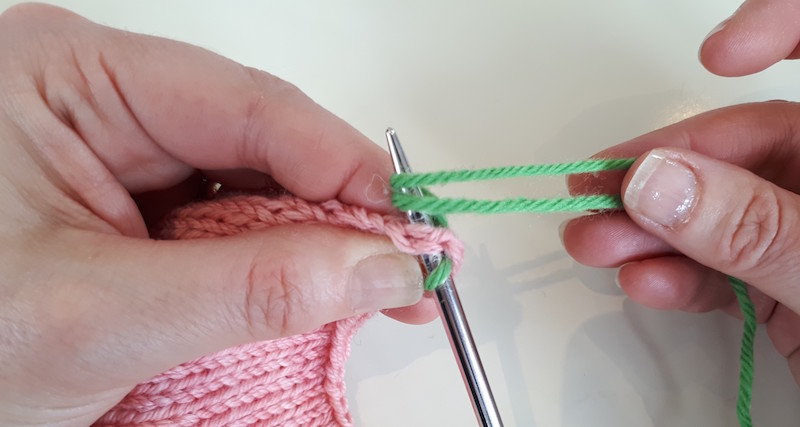
Picking up under a bound-off edge.
If you used a different method, you might not have a tidy lip. Poke the needle through the center of each stitch, in the complete stitch that’s closest to the edge (the first or last row).
Picking up under a cable cast-on edge.
Side Edges
See more : Celsius Caffeine: How Much Caffeine In Celsius Energy Drink?
Picking up along a side edge changes the rate of pick up. Knit fabrics aren’t square: there are more rows than stitches. Picking up stitches along the side of a piece of fabric means that you will be working perpendicularly to the fabric, so you need to create stitches over rows, and therefore consider the relationship of the two gauges. A gauge of 18 sts/24 rows has a ratio of 3 to 4; a gauge of 20 sts/28 rows has a ratio of 5 to 7. The ratio tells you how many stitches to pick up over how many rows—in the first example, 3 stitches in 4 rows, in the second 5 stitches in 7 rows. As you work across, you’ll skip loops/stitches on the edge. If using a 3-to-4 ratio, pick up in 3 adjacent rows, and skip the fourth.
(If you don’t know the precise gauge of the fabric you’re using, you can safely assume a 3-to-4 ratio for stockinette stitch, a 1-to-2 ratio for garter stitch.)
As to where to poke the needle, this is easy: under both strands of the edge stitch.
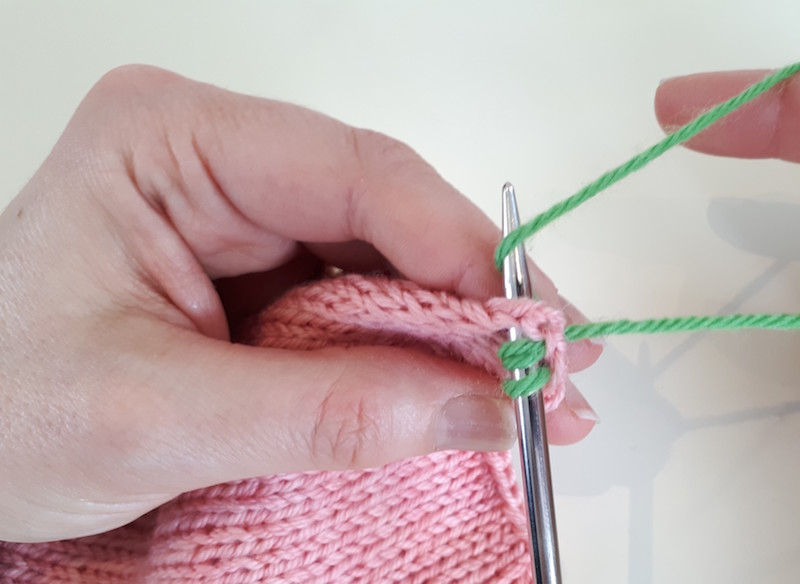
To Slip or Not to Slip
This is where the slipping, or not, of edge stitches becomes a crucial consideration: the short answer is that you need to pay attention to the pattern instructions. If you slip the edge stitches, that means you’re reducing the number of available places for picking up by half. It’s well-nigh impossible to pick up a 3 in 4 ratio, for example, on an edge with slipped stitches. So if the pattern doesn’t tell you to slip, don’t!
A side note: A top-down sock heel pattern will typically tell you to slip the first stitch of the row in the flap, and then have you pick up one for every slipped stitch along the edge. That means you’re picking up 1 stitch in every 2 rows. This works out because most sock heels are worked with a slipped-stitch pattern (Heel Stitch or Eye of Partridge) that compresses the row vertically, changing the gauge. If working a stockinette stitch heel, you shouldn’t slip that first stitch, and should use a ratio of 3 stitches to 4 rows.
Curves
And then the challenging one. You often have to pick up and knit stitches along edges where there have been decreases and stepped bind offs, such as around the armhole or neckline of a garment.
In these circumstances, there’s usually a combination of edges. You’ll probably have a bound-off edge in the center: that’s easy! Deal with that as any bound-off edge. You’ll probably have a straight vertical length. Deal with that as any side edge.
Where there’s a diagonal edge, for example, where decreases are worked every RS row, pick up 4 stitches for every 5 rows or so.
Really the only tricky bit is in the corners, at the sides of the steps, or in the curves of shaping. If you’re dealing with a stepped bind off, there’s an awfully tempting little hole, at the step. Avoid picking up a stitch in one of these oversized gaps. Look for a snugger stitch or smaller gap either side.
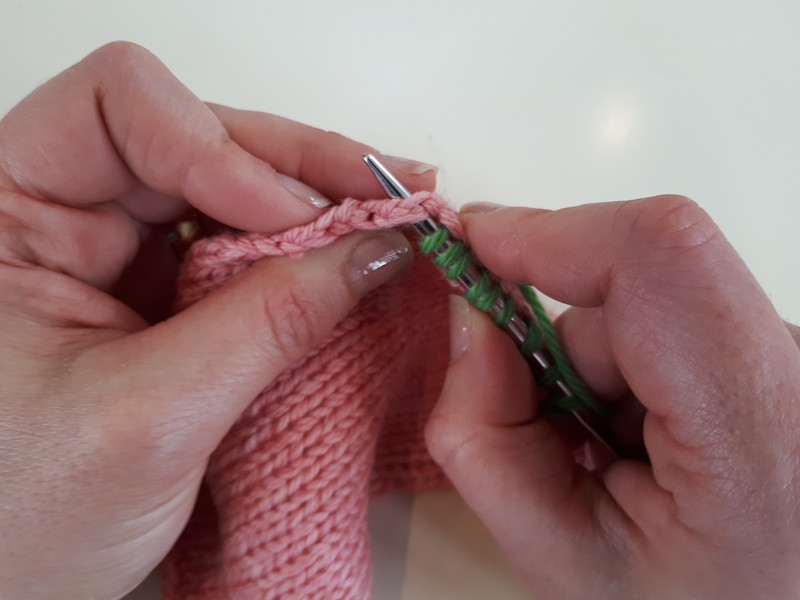
Resist this tempting little hole.
there, Aren’t you glad you resisted?
In Garments
Some patterns tell you how many stitches to pick up along an edge; others use a ratio. If you’re making an adult-size garment, it could be 100 or more stitches. If you’re working to a specific number, removable stitch markers are helpful: subdivide the length into quarters, and use that as guide for how to distribute the new stitches.

A Dirty Secret
If you don’t manage to get precisely the right number, and you’re off by a handful of stitches in either direction, it’s OK! It’s rare that I get exactly the number expected. Sometimes there just aren’t enough tidy places to pick up along a curve, or I lose count as I go. Work some sneaky increases or decreases in on the first row, to get to the count you need. (Some recommend picking up every stitch and then working decreases down to the required number: I don’t like this for two reasons: calculating the decrease can be tricky and/or annoying, and if there are a lot of decreases, it can get bulky and messy.)
A Hard Truth
Picking up stitches is sort of like going to the gym: most don’t like the process, but the results are worthwhile. And if it takes more than one visit to get the result you need, it’s worth persevering. Put another way: if you do the pick up and it doesn’t look good, it’s absolutely worth redoing. After all, these aren’t live stitches, so it’s a painless frog. These types of finishing details make all the difference in how your piece looks: the front edges are right there, front and center. Take an extra few minutes to make sure they look their best. After all, it’s not just others who will see this part of the garment, but you’ll see it every time you look at yourself in the mirror. Make sure you’re proud of your work!
Save it for Later
Don’t need to pick up stitches right now, but want to find Kate’s wisdom on the subject later? Here’s how to save this article in your MDK account with one click.
Nigel Gildon editor:Nigel Gildon is the editor of Chef Wayne’s Big Mamou: Chef Wayne’s Big Mamou. He has worked in the publishing industry for many years and has a passion for helping new authors get their work into the hands of readers. 63 Liberty Street * Springfield, MA 01003




